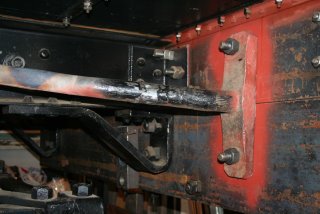 Even railroaders can't escape house keeping chores.
Even railroaders can't escape house keeping chores.Today was moving day for the El Dorado Western. Hard work, sweat and grime characterized this move as we emptied a Diamond Springs storage locker and moved our stuff to Denver & Rio Grande boxcar No. 3427 in the town of El Dorado.
I say "stuff" because we had collected a decade's worth of essential parts for the D&C No. 4 Shay as well as an odd collection of historic "junk."
EDWRF Director Ed Cunha told me this morning the we went through a phase where any donation was gladly accepted, whether it had value to the railway or not.
Included in the collection were two pieces with the hand-painted Four Spot on the 1940s steel cab. When restored, a handcrafted oak cab will replace the steel cab on the Shay.
The photo of railway President Eric Stohl (left) and volunteer Dale Mace with the Four Spot served as a fitting end to the six-hour move. Moments like this ease the drudgery of cleaning house.





 To weld the two rods, Dale slowly adds metal to the gap. He says that it makes a much stronger connection. If you weld flat pieces end-to-end, the end result is a very weak connection.
To weld the two rods, Dale slowly adds metal to the gap. He says that it makes a much stronger connection. If you weld flat pieces end-to-end, the end result is a very weak connection.
 Dale shapes the hole that will accept the iron rod.
Dale shapes the hole that will accept the iron rod.
